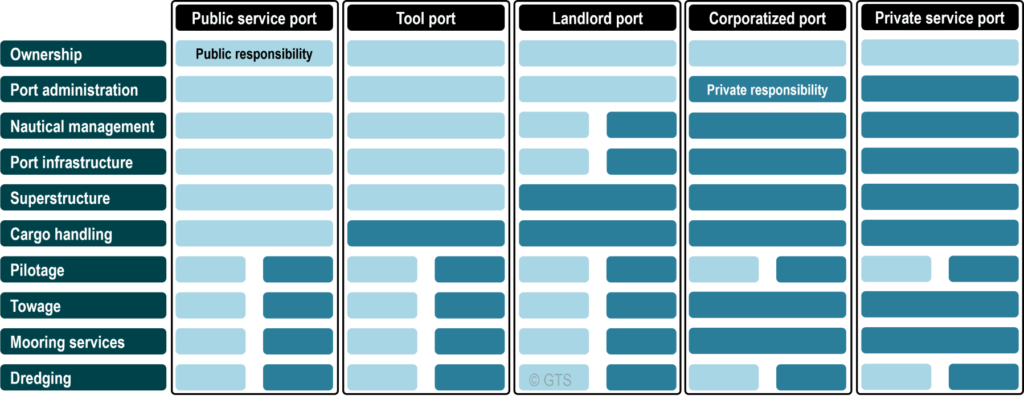There are five main port management models based on the respective responsibility of the public and private sectors. They include the public service port, the tool port, the landlord port, the corporatized port, and the private service port. Each of these models concerns ports with different characteristics concerning the ownership of infrastructure, equipment, terminal operation, and who provides port services such as pilotage and towage. While service and tool ports primarily promote public interests, landlord ports attempt to balance public and private interests. At the other end of the spectrum, private service ports are maximizing the interests of their shareholders.

1. Public service ports
The port authority of public service ports performs the whole range of port-related services and owns all the infrastructure. They are commonly a branch of a government ministry, and most of their employees are civil servants. Some ancillary services can be left to private companies. Because of the inefficiencies, they are related to, the number of public service ports has declined.
2. Tool ports
Similar to a public service port, the tool port differs only in the private handling of its cargo operations, albeit the port authority still owns the terminal equipment. In several cases, a tool port is a transitional form between a public service port and a landlord port.
3. Landlord ports
Represents the most common management model where infrastructure, particularly terminals, are leased to private operating companies with the port authority retaining ownership of the land. The most common form of lease is a concession agreement where a private company is granted a long-term lease in exchange for rent that is commonly a function of the size of the facility as well as the investment required to build, renovate or expand the terminal. The private operator is also responsible for providing terminal equipment to maintain operating standards.
4. Corporatized ports
Concerns ports have almost entirely been privatized, except that ownership remains public and often assumed as a majority shareholder. The port authority essentially behaves like a private enterprise. This management model is unique since it is the only one where ownership and control are separated, which lessens “public good” pressures landlord port authority faces and “shareholder value” pressures private ports face.
5. Private service ports
The outcome of the complete privatization of the port facility mandates that the facilities retain their maritime role. The port authority is entirely privatized, with almost all the port functions under private control, with the public sector retaining a standard regulatory oversight. Still, public entities can be shareholders and thus gear the port towards strategies that are deemed to be of public interest.
